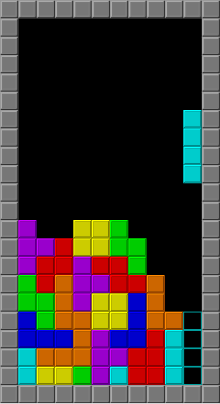Tetris
This article's citation style may be unclear. (February 2019) |
Tetris is a puzzle game, developed in the Soviet Union by Alexey Pajitnov in 1985.[1] It has appeared on many video game systems.
| Tetris | |
|---|---|
 A typical Tetris game screen | |
| Developer(s) | Vadim Gerasimov Vladimir Pokhilko Alexey Pajitnov |
| Designer(s) | Alexey Pajitnov |
| Platform(s) | List of Tetris variants |
| Release | Electronika 60
|
| Genre(s) | Puzzle, tile-matching |
| Mode(s) | Single-player, multiplayer |

Many companies have published Tetris games, such as Nintendo for the Game Boy and Nintendo Entertainment System. The Tetris Company, founded in 1996 by Pajitnov and Henk Rogers, manages and licenses the Tetris brand.
With over 500 million copies sold across all of its different versions, it is the best-selling video game of all time.[2]
Gameplay
changeIn a game of Tetris, shapes known as tetrominoes fall down into a playing field, which is usually ten squares wide and twenty squares tall. There are seven different tetrominoes.[3] The goal of the player is to move and turn the falling tetrominoes so they fill an entire row of the playing field. When a row is completely filled, it disappears and the lines above it move down to fill the space. This is called a line clear.
Clearing lines give points. A player gets more points if they clear more than one line with one tetromino. Clearing one line is called a "single", two lines a "double", three lines a "triple", and four lines a "Tetris".[4] Clearing two Tetrises in a row is called a Back-to-Back Tetris. The player can also turn a T-shaped Tetrimino into a T-shaped hole before it finishes falling to get more points.[4] This move is called a "T-Spin".
Levels have a set goal, or number of lines to clear. When the goal number reaches zero, the player moves to the next level. As the levels go up, tetrominoes fall faster.
Modern versions of Tetris follow a set of rules written by The Tetris Company. These rules, known as the "Tetris Guideline", make sure all Tetris games look and feel familiar.[5][6] For example, these rules state what each button on a game controller must do, and what colour each tetromino should be.
In older versions of the game, the player loses when the tetrominos make it to the top of the playing field. In more modern versions of the game, they can lose in two ways. The first is when they place a piece completely above the playing field. The second way to lose is if a player places a piece that blocks the next piece from spawning in.[source?]
Music
changeOn the Game Boy, there are several musical themes played. The theme for level 1 and used in the Game Boy version is often called the "Tetris Theme". It is actually a Russian dance called Korobeiniki, or "The Peddlers". It was arranged for the Game Boy by Hirokazu Tanaka. Other themes include music by Johann Sebastian Bach and the Dance of the Sugar Plum Fairy.
References
change- ↑ "Tetris | video game | Britannica". www.britannica.com. Retrieved 2023-04-18.
- ↑ Langston, Keith (August 22, 2021). "The 10 Bestselling Video Games Of All Time". Screen Rant. Retrieved March 9, 2022.
- ↑ The Tetromino Facts. 2009, Tetris Press.
- ↑ 4.0 4.1 "Tetris Terminology". Archived from the original on 2011-10-20. Retrieved 2011-10-30.
- ↑ "History of Tetris®". Tetris. Retrieved 2023-09-15.
- ↑ "Tetris from the Top: An Interview with Henk Rogers - Interview". Nintendo World Report. Retrieved 2023-09-15.